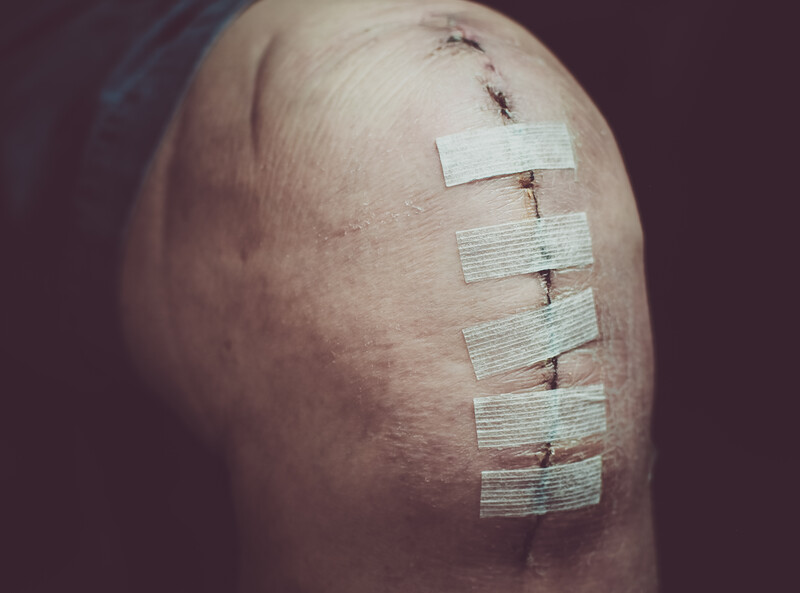We often receive a phone call or an email from someone who was just told that they should consider a partial knee replacement surgery. Problem is they cannot get the surgery for months. Now what? Their MRI, they tell us, revealed advancing knee osteoarthritis or more commonly, a “bone on bone situation.” This person will then emphasize to us that they “need” a knee replacement because “I have no cartilage left. My doctor says that I should schedule the surgery now.”
Since we do not perform knee replacement surgeries in our practice, why then are these people contacting us? Simply, they are not convinced that total knee replacement is the best choice for them and they are looking for options.
For many years researchers have been curious as to why anyone would turn down a knee replacement surgery when outcomes were so good. Many people have very successful knee replacement surgeries. So why turn it down?
Reasons people give for not wanting knee replacement surgery
They are a caregiver. Often overlooked by doctors, a spouse who acts as a caregiver cannot see how they themselves can get through the surgery’s rehabilitation period while continuing to care for their spouse who has their own medical needs. Many see the knee replacement of the caregiver as a ticket to send both husband and wife to nursing home confinement.
They own a business that is physically demanding. General contractors in home or building construction fall into this category along with ranch owners or stable owners, farmers, landscapers, dog walkers or any business where the owner is “hands on.” It is not only the rehabilitation time, it is the perceived limitations in what they can do post-surgery that concerns these business people.
They are active people who want to stay active. Let’s say you are a golfer. How fast can you get back on the course and play a “meaningful game?” Some suggest within days of the surgery, others suggest a more realistic 18 weeks. Many golfers find that they do not walk the course after the knee replacement, they take the cart. Knee replacement can present challenges of limitations.
They have a fear of complications. Not all knee replacement surgeries are successful. Some knee replacement surgeries create more problems than they solve.
These are only some reasons, there are other reasons including health concerns, diabetes, obesity, cardiovascular disease being some of them. But your knee is in pain, you already have limitations in mobility, you have a diminished quality of life, is NOT having the knee replacement a realistic option?
Are there realistic alternatives to knee replacement? Yes, especially if you did not need surgery in the first place.
Someone who has been told that they “must have” a knee surgery is often taken by surprise by another doctor telling them that they do not. This is often a happy surprise for this person. But, they also wonder, how can this be? Their MRI showed “bone on bone,” no cartilage,” “degenerative damage” and they have knee pain. How do they not need the surgery?
In 2014, a study and an editorial were published in the journal Arthritis & Rheumatology. At the root of these two papers was the finding that more than one third of total knee replacements offered by doctors in the United States are “inappropriate” treatments for patients.
In the study lead by Dr. Daniel Riddle from the Department of Physical Therapy at Virginia Commonwealth University, (1) Dr. Riddle and his colleagues wrote:
Many patients struggle with the decision of whether to undergo total knee replacement surgery. Patients must consider issues such as their symptom severity and psychological readiness, as well as surgical risk and recommendations of the surgeon and other members of the health care team.
Of note in this study was that patients whose knees “were not that bad,” were being recommended to replacement surgery. Dr. Riddle wrote, “Our finding that one third of knee replacements were inappropriate was higher than expected and linked to variation in knee pain, osteoarthritis severity, and functional loss.”
In the related editorial, Dr. Jeffery Katz from the Orthopedic and Arthritis Center for Outcomes Research at Brigham and Women’s Hospital in Boston writes, (2) “Rates of utilization differ markedly across hospital service areas, suggesting uncertainty among physicians regarding indications for total knee replacement. With total knee replacement rates projected to increase further in coming decades, it is reasonable to ask whether the procedures are being done today for appropriate indications.”
In a 2020 study,(3) this thinking extending to partial knee replacements as well. Here is the summary of that paper:
“Unicompartmental knee arthroplasty (partial knee replacement) is a promising treatment option for unicompartmental knee osteoarthritis and widely used.It just replaces the lesion (damaged) compartment with many advantages such as a smaller incision, less soft tissue injury, and more rapid recovery.
(Partial knee replacement) restores the native knee kinematics as the other compartments and knee ligaments are largely retained. Although there were many evidences that Partial knee replacement could achieve good results when patient selections and surgical techniques were accurate.However, some (studies) reported that partial knee replacement prostheses had lower survival rates compared to total knee replacement.”
Avoiding knee replacement with just exercise
Five years later, in September 2019, utilizing in part the findings of this research, doctors in Sweden determined that for some patients there may be a better way for pain relief and better mobility than knee replacement. Just exercise. They published their results in the journal PlusOne. (4)
In their study the doctors evaluated a structured education and exercise-based self-management program for patients with knee or hip osteoarthritis. They used outcome data from a earlier Swedish study called “Better Management of Patients with Osteoarthritis.”
What they measured at baseline, three months, and one year was:
Patient’s pain severity.
Patient’s pain frequency.
Medication usage for osteoarthritis related pain or inflammation.
The desire of the patient to have joint replacement surgery.
The patient’s fear of having the surgery or of daily movement.
The patient’s level of physical activity.
The amount of sick time the patient was off their job.
At the 3-month follow-up, patients with knee osteoarthritis reported significant improvements in pain and quality of life, significantly fewer patients reported pain of more than once weekly, significantly fewer patients took osteoarthritis medication, significantly fewer patients desired surgery, significantly fewer patients showed fear-avoidance behavior, and significantly fewer patients were physically inactive.
At the 12-month follow-up, significantly fewer patients reported daily pain. Following the exercise interventions, patients with knee osteoarthritis experienced significant reductions in symptoms and decreased willingness to undergo surgery, while using less osteoarthritis medication and taking less sick leave. The results indicate that offering an exercise program as the first-line treatment for osteoarthritis patients may reduce the burden of this disease. In other words, less knee replacements.
When your knee is too unstable or too painful for exercise, now what?
The goal of being able to exercise is one of the most sought after treatment goals that we see in our patients. For some, exercise is a dream, not a reality because of their knee pain. At the Magaziner Center for Wellness, we take a holistic approach, extensively testing each of our patients to determine all causes and contributing factors to their knee pain to see if we can provide a realistic alternative to knee replacement.
When it comes to treatment, we can offer the patients prolotherapy, platelet-rich plasma therapy and regenerative therapies. These treatments are designed to repair the joint.
We have numerous articles on our website that can help provide more information on knee replacement alternatives. Some are listed below. If you would like to explore more information, please contact our office so we can start a conversation with you.
Related articles:
https://drmagaziner.com/knee-pain/stem-cell-treatments-for-bone-on-bone-knees/
Researchers Say Knee Osteoarthritis Patients Need Vitamin D
Researchers Say Knee Osteoarthritis Patients Need Vitamin D
Researchers Say Knee Osteoarthritis Patients Need Vitamin D
Researchers Say Knee Osteoarthritis Patients Need Vitamin D
References:
1 Riddle DL, Jiranek WA, Hayes CW. Use of a validated algorithm to judge the appropriateness of total knee arthroplasty in the United States: a multicenter longitudinal cohort study. Arthritis Rheumatol. 2014 Aug;66(8):2134-43. doi: 10.1002/art.38685. PMID: 24974958; PMCID: PMC4190177.
2 Katz JN. Appropriateness of total knee arthroplasty. Arthritis & rheumatology (Hoboken, NJ). 2014 Aug;66(8):1979-81.
3. Guo WS. Role and controversy of unicompartmental knee arthroplasty in treatment of knee osteoarthritis. Zhonghua wai ke za zhi [Chinese Journal of Surgery]. 2020 Jun 1;58(6):411-5.
4 Jönsson T, Eek F, Dell’Isola A, Dahlberg LE, Ekvall Hansson E. The Better Management of Patients with Osteoarthritis Program: Outcomes after evidence-based education and exercise delivered nationwide in Sweden. PLoS One. 2019 Sep 19;14(9):e0222657. doi: 10.1371/journal.pone.0222657. PMID: 31536554; PMCID: PMC6752869.
1400





































Recent Comments